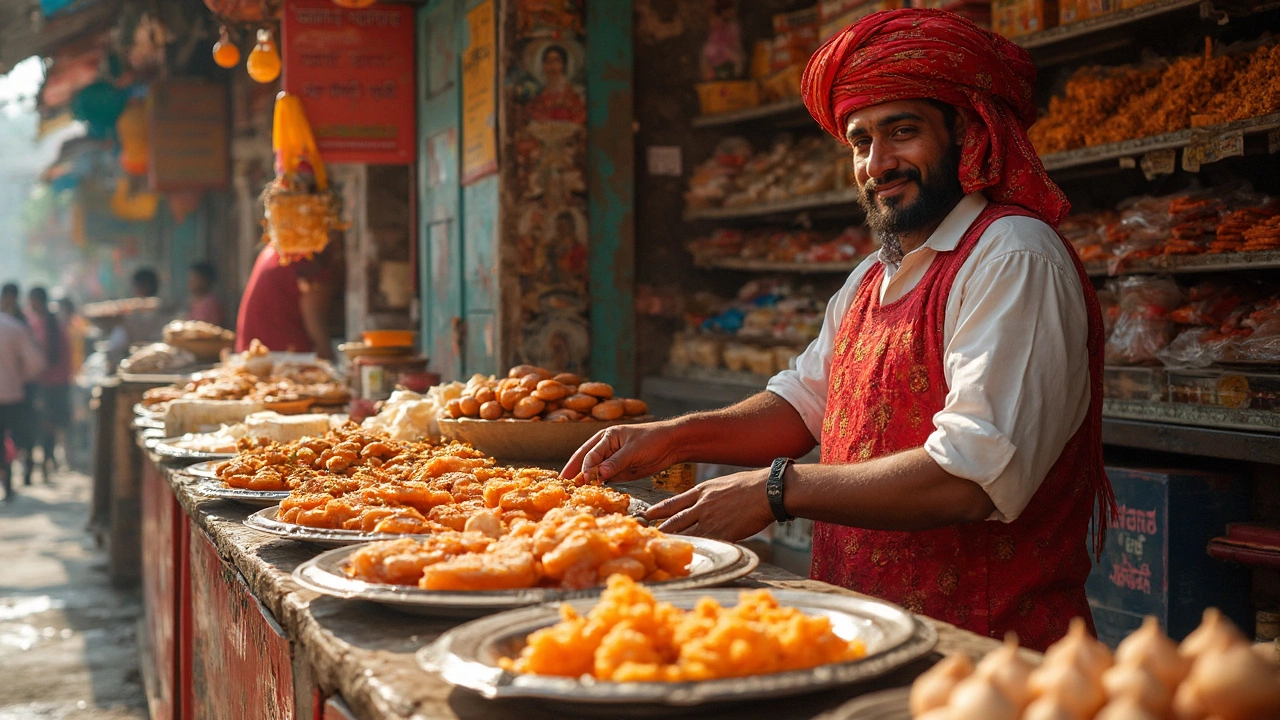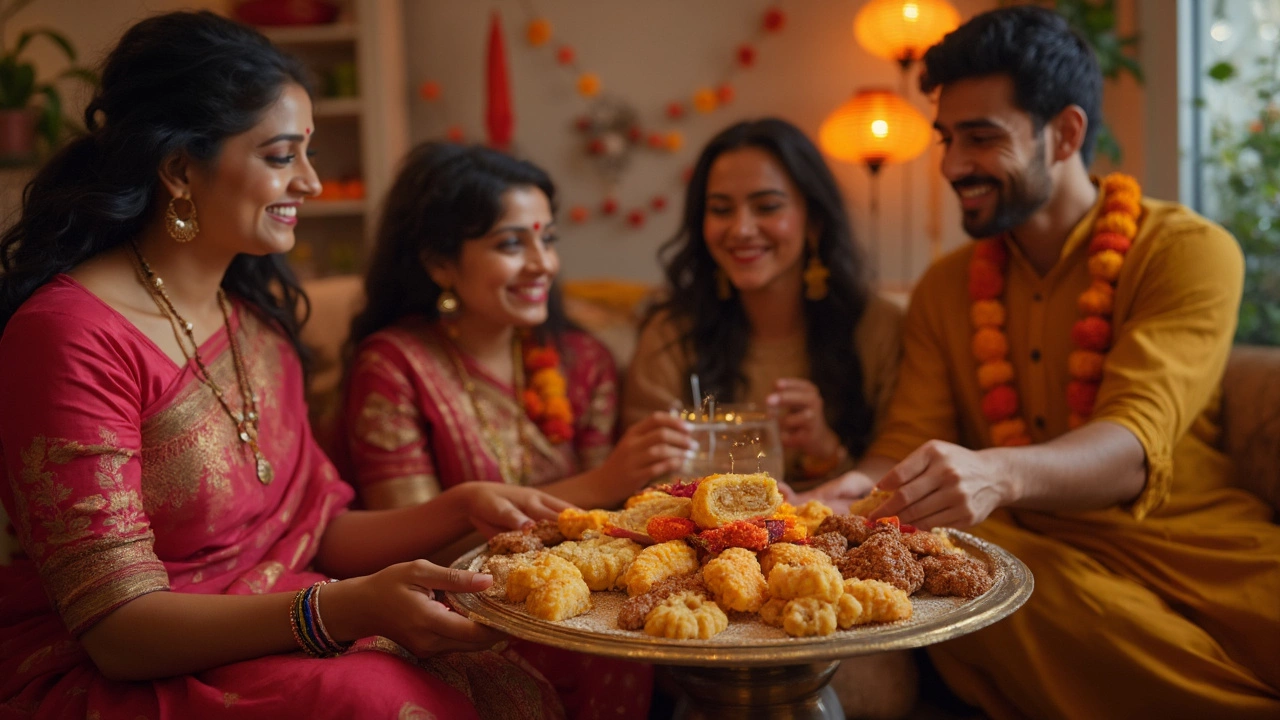If you’ve ever walked through an Indian market during festival season, you know the delicious chaos of sweet shops elbow-to-elbow and trays piled high with every color you can imagine. It’s not just about dessert—these sweets are woven into every Indian celebration, from Diwali lights to family weddings and Sunday lunches.
What makes a sweet truly ‘Indian’ isn’t just sugar and ghee. You’ll see recipes passed down for generations, each with a backstory—some shaped by local flavors like Bengal’s use of fresh cottage cheese, while others come loaded with nuts, dry fruits, or cardamom. No two regions do mithai the same way. One state’s must-have could be totally unknown just a few hundred kilometers away.
If you’re curious about what goes into these treats or want to try making one yourself, it’s actually less complicated than it looks. Many classic Indian desserts use just a handful of ingredients—think milk, sugar, flour, or lentils—with most of the magic coming from timing and a little patience. Want that melt-in-the-mouth gulab jamun or crispy jalebi swirl? Start with solid basics and keep a few pro tricks in mind.
- India’s Sweet Traditions: A Quick Look
- Famous Regional Sweets and What Sets Them Apart
- How Traditional Indian Sweets Are Made
- Handy Tips for Making and Enjoying Indian Mithai
India’s Sweet Traditions: A Quick Look
The story of Indian sweets is older than pretty much any bakery you know. There’s proof that mithai has been around since ancient times, popping up in records and temple rituals over 2,000 years ago. Back then, sweets weren’t just eaten for fun—they were often part of religious offerings or handed out to mark special occasions.
Every major festival in India—whether it’s Holi, Diwali, Eid, or Christmas—has a go-to sweet. Classics like laddoo, barfi, and kheer show up year after year, tweaked in kitchens across the country. It’s common for families to make their own signature recipes at home, but sweet shops are packed with people picking up giant boxes every weekend. Friends and neighbors love swapping sweets, and no family gathering is complete without them.
There’s a wild range in how traditional desserts look and taste across India. Bengal is famous for soft, juicy rasgulla. In the west, Gujarat leans towards dense, nutty sweets like mohanthal. Down south, payasam (a kind of rice pudding) is the star at just about every festival. Each region puts its stamp on classic recipes—sometimes even changing color, texture, or flavor to fit local tastes.
Mithai is also about more than sugar. Typical ingredients include ghee, milk, jaggery, and locally grown spices. Even today, lots of people prefer using jaggery (unrefined sugar) or honey, especially in rural parts of India. Spices like cardamom, saffron, and even black pepper bring out flavor and make these treats unique.
| Popular Festivals | Signature Sweets |
|---|---|
| Diwali | Laddoo, Barfi, Jalebi |
| Holi | Gujiya, Malpua |
| Eid | Sheer Khurma, Seviyan |
| Pongal | Pongal, Payasam |
Don’t be surprised to find even small towns with a famous specialty known far and wide. Many Indian sweets have ‘GI tags’—a kind of certification saying that only sweets made in that place can use the name. For example, only rasgullas from West Bengal get the official tag. This keeps traditions strong and sparks plenty of healthy debate over which state makes the best mithai.
Famous Regional Sweets and What Sets Them Apart
India’s obsession with Indian sweets is serious business—every region has its own superstar dessert, and locals will fiercely defend their favorite. Some of these treats even have government-certified tags (like the Geographical Indication tag) to protect their ‘authentic’ status.
Let’s break down a few iconic regional Indian sweets:
- Rasgulla (Bengal & Odisha): Soft white cheese balls soaked in sugar syrup. Bengal is known for the spongy type, but Odisha has an ancient claim with a firmer version, served at Puri’s Jagannath Temple.
- Jalebi (North India): Bright orange, crispy spirals soaked in saffron syrup. You’ll find piping hot jalebi at almost every street corner, especially during festivals or wedding breakfasts.
- Gulab Jamun (Across North India): Deep-fried dumplings made from khoya (milk solids), steeped in cardamom-flavored syrup. Served warm, it’s a default dessert for Indian parties.
- Mysore Pak (Karnataka): A firm, buttery sweet made with chickpea flour, sugar, and loads of ghee. Invented in the royal Mysore palace, it has a crumbly texture that melts in your mouth.
- Sandesh (West Bengal): Made from fresh chenna (paneer), sweetened lightly and sometimes flavored with rose or cardamom. It’s all about delicate taste without being overpoweringly sweet.
- Peda (Uttar Pradesh): Dense, milk-based sweets, often flavored with cardamom or saffron. Mathura is legendary for its pedas, handed out as prasad in temples.
- Soan Papdi (Western India): Wispy, flaky squares made from gram flour and ghee with cardamom. Commonly given as Diwali gifts, but available year-round in most sweet shops.
Check out this quick snapshot to see how these traditional desserts differ by base ingredient and texture:
| Sweet | Main Ingredient | Texture | Region |
|---|---|---|---|
| Rasgulla | Chenna (cottage cheese) | Spongy, juicy | Bengal, Odisha |
| Jalebi | Flour | Crispy, syrupy | North India |
| Gulab Jamun | Khoya | Soft, syrupy | North India |
| Mysore Pak | Chickpea flour | Crumbly, rich | Karnataka |
| Sandesh | Chenna | Soft, light | West Bengal |
The list doesn’t stop here. States like Rajasthan are famous for ghewar, Maharashtra has modak, and Kerala has payasam. Each of these traditional desserts brings together local flavors and ages-old techniques. If you travel across India, you’ll see that local ingredients—milk, jaggery, ghee, nuts—decide what people grow up eating on special days. This mix gives Indian sweets their wild variety, and keeps snack counters interesting.

How Traditional Indian Sweets Are Made
Making Indian sweets usually starts with easy-to-find stuff: milk, sugar, flour, ghee, nuts, or lentils. What’s interesting is how each region takes these basic things and creates something totally unique—no wonder these traditional desserts feel so special at every celebration.
The backbone for a lot of iconic sweets like barfi, peda, and rasgulla is milk. But Indians don’t just use milk as it is. They usually boil it down (called khoya or mawa) or split it with lemon or vinegar to get chenna, which is basically fresh cottage cheese. If you love rasgulla or sandesh, that unique spongy bite comes from the chenna’s fresh texture. For others—like ladoos or halwa—people rely on flours or lentils, toasting them in ghee until your kitchen smells like a festival.
If you think it takes a super fancy kitchen to make these sweets, forget it. You just need patience and a little know-how. Here’s a basic run-through for some of the classic mithai:
- Gulab Jamun: Mix khoya (dried milk solids) with a bit of flour, roll into small balls, fry till golden, and soak in cardamom-scented syrup.
- Jalebi: A batter of flour and a touch of yogurt gets swirled right into hot oil, then the crispy shapes soak in sugar syrup for that iconic crunch and tang.
- Kaju Katli: Cashew powder, sugar syrup, a touch of ghee, then rolled thin. That’s it. Sometimes a little silver foil for tradition.
- Ladoo: Made with roasted gram flour or semolina, mixed with ghee and sugar, shaped into balls.
It helps to keep a candy thermometer if you’re aiming for the perfect sugar syrup (especially for gulab jamun or jalebi), but honestly, Indian home kitchens usually go by sight, smell, or that old-school drop test (drop some syrup in water, see if it forms a soft ball).
Check out this quick table to see some different base ingredients used in famous Indian recipes:
| Sweet | Main Ingredient | Region |
|---|---|---|
| Rasgulla | Chenna (cottage cheese) | Bengal |
| Kaju Katli | Cashews | Pan-India |
| Besan Ladoo | Gram flour | North & West India |
| Jalebi | All-purpose flour | North India |
One big tip: The fresher the ingredients, the better your sweets taste. And don’t skip on the quality of your ghee and cardamom—it makes a huge difference. Even small mistakes in syrup consistency can totally change the texture, so it’s usually safer to do a trial run before you cook for a crowd.
Handy Tips for Making and Enjoying Indian Mithai
Making Indian sweets at home can be surprisingly doable (and honestly, way more fun than people think). The pros at most Indian sweet shops swear by a few basic moves. Here’s what actually works in a home kitchen:
- Start simple: Sweets like sooji halwa (semolina pudding) or coconut ladoos only use a handful of pantry basics. Nail these before jumping into complicated stuff like layered burfis or fancy sugar art.
- Measure everything: In Indian desserts, fudgy or crumbly happens fast if you eyeball measurements—especially with things like ghee or milk solids. A cup means a cup.
- Heat makes all the difference: Most mithai needs low, slow cooking. Fast heat burns milk-based recipes or makes sugar syrup crystallize. Small burner, heavy pan, and stay patient.
- Get the sugar syrup right: A lot of Indian sweets—rasgulla, gulab jamun, jalebi—depend on syrupy magic. The sugar syrup needs the right consistency: not watery, not rock-hard. Use the old-school trick—drop a little in water to see if it forms a soft ball.
If you find yourself buying store-bought sweets, freshness matters. Most traditional sweets, especially those made with milk like rasgulla and peda, taste best the day they’re made. And while some mithai stores use preservatives, freshly made always wins for flavor.
As Tarla Dalal, India’s best-loved cookbook author, once said, “For every festival, there is a mithai—and every mithai has a little secret that makes it unique. Never skip those tiny steps.”
Here’s a quick look at how long you can keep common Indian sweets fresh at home:
| Sweet Dish | Type | Shelf Life (Refrigerated) |
|---|---|---|
| Gulab Jamun | Milk-based | Up to 7 days |
| Ladoo | Dry | 2-3 weeks |
| Barfi | Milk/nut based | 1 week |
| Jalebi | Sugar-based | 2-3 days (for best crunch) |
| Rasgulla | Milk-based | 1 week |
Don’t forget, some sweets make easy edible gifts. Ladoo or dry barfi travel well, while syrupy or creamy desserts are best kept chilled and eaten sooner. And honestly, there’s no wrong way to enjoy traditional Indian desserts—whether with hot chai, after a meal, or just because you feel like it.
